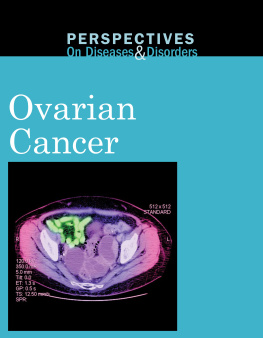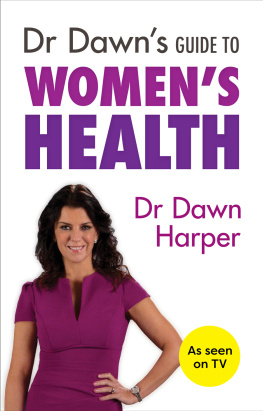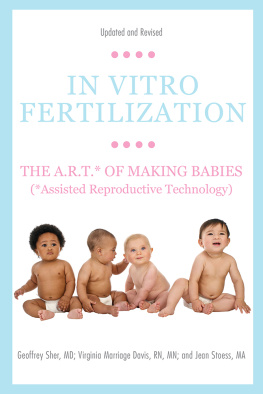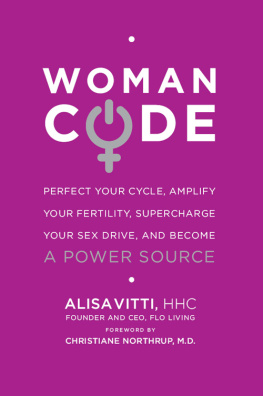The NaPro TECHNOLOGY Revolution
Unleashing the Power in a Womans Cycle
The NaPro TECHNOLOGY Revolution
Unleashing the Power in a Womans Cycle
THOMAS W. HILGERS, MD

What every woman has a right to know about her body...her health...her future!
Copyright 2010 by Thomas W. Hilgers, MD
Pope Paul VI Institute
All Rights Reserved
With the exception of short exerpts for critical reviews, no part of this book may be reproduced in any manner whatsoever without permission in writing from the publisher.
Library of Congress Cataloging-in-Publication Data
Hilgers, Thomas W., 1943
The naprotechnology revolution : unleashing the power in a womans cycle/
Thomas W. Hilgers.
p. cm.
Includes bibliographical references and index.
ISBN 978-0-8253-0626-6 (alk. paper)
1. Natural family planning. I. Title.
RG136.5.H552 2010
613.94dc22
2010018419
10 9 8 7 6 5 4 3 2 1
Design and layout: Erik E. Baumgart, BFA
Layout editing: Victoria L. Sage, BSc
Cover design: Victoria L. Sage, BSc
Printed in China
Published by:
Beaufort Books
New York, New York
www.beaufortbooks.com
* The term NaProTechnology has been registered in the U.S. Patent and Trademark Office by the Pope Paul VI Institute for the Study of Human Reproduction. It can be used freely by any person or entity as long as its use reflects the medical concepts and values presented in the textbook,
The Medical & Surgical Practice of NaProTECHNOLOGY,
Pope Paul VI Institute Press, Omaha, Nebraska, 2004.
Tips On How to Use This Book
YOU SHOULD APPROACH this book in a way that will allow it to be the most help to you. Here are a few tips for letting that happen.
First of all, by reading the authors introduction, you will get a sense of the feel, emotion and capability of the new womens health science, NaProTECHNOLOGY (Natural Procreative Technology).
The first four chapters of the book are important reading because they give you a good background on why NaProTECHNOLOGY and the CREIGHTON MODEL Fertility Care System were developed, what the motivating forces have been and a contrast between two different approaches to reproductive medicine. These first four chapters are a must read for everyone.
give the reader a review of basic anatomy and physiology, the various hormones of the menstrual and fertility cycle, how they interact and how they work. It also will introduce the reader to a variety of different myths, areas of ignorance and various insults that have been leveled at this work over the years. This, too, should be considered a must read.
The next series of chapters, of a variety of conditions from which women of reproductive age suffer. It will introduce the reader to the CREIGHTON MODEL, how it can be used to date the beginning of a pregnancy, and how it can be used to target the cycle correctly for the proper and adequate evaluation of certain hormones that are produced during the course of the menstrual and fertility cycles. In addition to that, these chapters will introduce the reader to various aspects of normal and abnormal ovarian function, the difference between hormones that are produced normally in the body and artificial chemicals that are currently used day-in and day-out for the treatment of various conditions (in this book these are called artimones, artificial substitutes for hormones). It will introduce the reader to the use of progesterone support during the course of pregnancy and also the surgical aspects of NaProTECHNOLOGY. Perhaps the most important is the basic description of the charting system of the CREIGHTON MODEL. A little study of this chapter will help you immensely to understand the ensuing chapters.
Ultimately, NaProTECHNOLOGY has components that are medical, surgical and pregnancy-related. Once the first 14 chapters have been read, then the remaining portions of the book can be read in any order. This will undoubtedly be related to what your interest might be or what your own personal medical problem might be. Of course, we think that all of the chapters are important and you might wish to read about all of them, but definitely begin with those chapters that are most pertinent to your own situation.
Most of these chapters are not complex in their reading. However, a few of them are more technical, particularly from a medical point of view. Even though they have been written in a fashion that is strictly not overly medical, the lay reader may still find some of it technical. Thus, for your individual use, we have placed, at the conclusion of this book, a Glossary of Terms that you can use to better understand some of the more technical chapters.
Concepts presented in this book are heavily documented. The complete reference list, for those who might be interested, can be downloaded from the Internet Appendix for this book ( www.unleashingthepower.info ). There are additional resources at this website that can also be downloaded (at no charge).
Throughout the book, there are patient testimonials and comments that re-enforce the medical and educational substance of the content.At the conclusion of a number of the chapters, there are Action Items and more technical details for physicians under For the Doctor.
At the conclusion of the book, there are chapters that deal with the cost-effectiveness of NaProTECHNOLOGY, the need for insurance reform, and other important elements to the future of this new science and to your health. These chapters also should be read to give you the complete breadth of what this work challenges us to do.
About the Author
Thomas W. hilgers, MD, Dip. ABOG, ABLS, SRS, CFCMC
Director of the Pope Paul VI Institute for the Study of Human Reproduction in Omaha, Nebraska, he began his first research in the natural regulation of human fertility in 1968 as a senior medical student. Working at St. Louis University and Creighton University Schools of Medicine, he and his co-workers developed the CREIGHTON MODEL Fertility CareSystem. Those intrinsically involved in the development of this system for the last 34 years, along with Dr. Hilgers, are K. Diane Daly, RN, CFCE; Susan K. Hilgers, BA, CFCE; and Ann M. Prebil, RN, BSN, CFCE.
Dr. Hilgers is currently a senior medical consultant in obstetrics, gynecology, reproductive medicine and surgery at the Pope Paul VI Institute and is a Clinical Professor in the Department of Obstetrics and Gynecology at Creighton University School of Medicine. He is director of the Institutes Education Programs and its National Center for Womens Health. He is board certified in Obstetrics and Gynecology, Gynecologic Laser Surgery and he is a member of the Society of Reproductive Surgeons. Furthermore, he is certified by the American Academy of Fertility Care Professionals (AAFCP) as a Fertility Care Medical Consultant (CFCMC). In 1994, Dr. Hilgers, along with his wife, Susan, was named by Pope John Paul II to a five-year term to the Pontifical Council for the Family, and he also was appointed an active member of the Pontifical Academy for Life.
Next page








